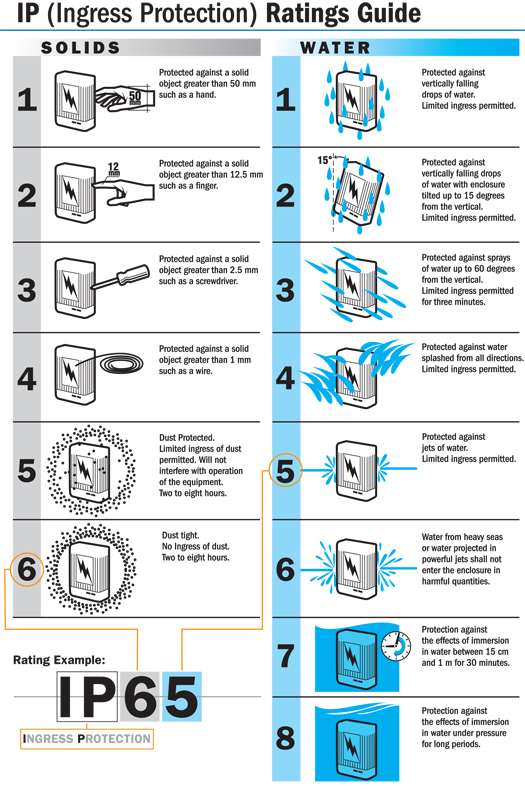Electronic equipment is used in various applications and has to work safely for a long period of time and under adverse environmental conditions. Dust and humidity cannot always be avoided, nor can the presence of foreign bodies. The different protection classes establish the extent to which an electrical appliance can be exposed to adverse environmental conditions without being damaged or posing a safety or health risk.
If you review the technical sheets of these devices, you will surely easily find codes formed by the letters IP followed by two digits, referring to their degree of protection.
We will explain it to you in a simple way:
The IEC or International Electrotechnical Commission, (also known as IEC for its acronym in English), establishes regulations to classify the different degrees of protection that the outer coating of the equipment or device has, against the entry of solid and liquid bodies (mainly powder or water).
To interpret the IP protection degree, you must take into account that:
First of all there are the letters IP, which are the acronym for Ingress Protection, they always appear. Some numerical values are specified below:
The first is the one that tells us the degree of resistance that the device has against the entry of solid elements, mainly dust. The values can range between 0 and 6. If it starts from the number 6, we can deduce that the device is completely sealed to prevent dust from entering, an element specifically harmful to the internal components of any electronic device.
Next, a second number would be included, which indicates the type of protection that the equipment has against liquids, usually fresh water, because other liquids can be corrosive, the values can range between 0 and 8.
Thus, the lowest degree of protection that we can find is IP00 and the highest is IP68. As a general rule, we can say that the higher the IP grade, the more protected and isolated the equipment is against the entry of external agents.
To be clear about what each value indicates, we present the following table where you can find the description of each value.
First digit. Refers to the entry of solid bodies
| NIVEL | DESCRIPCIÓN |
| 0 | Sin protección. |
| 1 | Protegido contra la entrada de elementos sólidos de hasta 50mm. |
| 2 | Protegido contra la entrada de elementos sólidos de hasta 12,5mm. |
| 3 | Protegido contra la entrada de elementos sólidos de hasta 2,5mm. |
| 4 | Protegido contra la entrada de elementos sólidos de hasta 1mm. |
| 5 | Protegido contra la entrada de polvo (la cantidad que entra no interfiere con el funcionamiento del dispositivo). |
| 6 | Totalmente protegido contra la entrada de polvo. |
Second digit. Refers to the entry of solid bodies
| NIVEL | DESCRIPCIÓN |
| 0 | Sin protección. |
| 1 | No debe entrar el agua cuando se la deja caer, desde 200mm de altura respecto del equipo, durante 10 minutos (a razón de 3-5mm³ por minuto). |
| 2 | No debe entrar el agua cuando se la deja caer, durante 10 minutos (a razón de 3-5mm³ por minuto). Dicha prueba se realizará 4 veces a razón de una por cada giro de 15º tanto en sentido vertical como horizontal, partiendo cada vez de la posición normal de trabajo. |
| 3 | No debe entrar el agua nebulizada en un ángulo de hasta 60º a derecha e izquierda de la vertical a un promedio de 11 litros por minuto y a una presión de 800-100 km/m² durante un tiempo que no sea menor a 5 minutos. |
| 4 | No debe entrar el agua arrojada desde cualquier ángulo a un promedio de 10 litros por minuto y a una presión de 800-100 km/m² durante un tiempo que no sea menor a 5 minutos. |
| 5 | No debe entrar el agua arrojada a chorro (desde cualquier ángulo) por medio de una boquilla de 6,3 mm de diámetro, a un promedio de 12,5 litros por minuto y a una presión 30 km/m² durante un tiempo que no sea menor a 3 minutos y a una distancia que no sea menor de 3 metros. |
| 6 | No debe entrar el agua arrojada a chorros (desde cualquier ángulo) por medio de una boquilla de 12,5 mm de diámetro, a un promedio de 100 litros por minuto y a una presión 100 km/m² durante un tiempo que no sea menor a 3 minutos y a una distancia que no sea menor de 3 metros. |
| 7 | El equipo debe soportar sin filtración alguna la inmersión completa a 1 metro durante 30 minutos. |
| 8 | El equipo debe soportar sin filtración alguna la inmersión completa y continua a la profundidad y durante el tiempo que especifique el fabricante del producto con el acuerdo del cliente, pero siempre que resulten condiciones más severas que las especificadas para el valor 7. |
All our membrane keyboards have a Protection Degree of IP65 (as long as the entrance slot of the tail to the equipment is sealed), and depending on the model and customer requirements we can manufacture keyboards that meet IP67, which guarantees a very high level of protection. protection, durability, and good performance over time.
Every membrane keyboard is different, contact us and we will find the best solution for your project!
